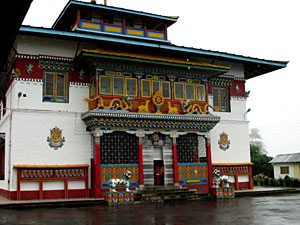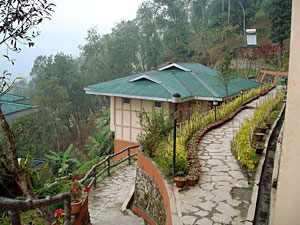|
|
|
Phodong, Sikkim |
|
|
|
Phodong is situated around 1 km southeast near the Km 39 post.
Phodong is situated 38 kms. north of Gangtok, in North Sikkim
district. The main occupation is farming on terraced slopes,
though in recent years, tourism has contributed to the
economy. Phodong is basically an eating place for the tourists
(mostly local) visiting the beautiful destinations of North
Sikkim. Phodong is famous for the Phodong Monastery and the
Labrang Monastery which is situated at a slightly higher
altitude then the Phodong Monastery.
Tourist Attractions in Phodong
The tourist attractions in Phodong are Phodong Monastery,
Labrang Monastery. |
|
|
|
Phodong Monastery
A 15-minute walk along a very degraded former road leads
to the Phodong Monastery, established in 1740. The
original monastery has been rebuilt and is today one of
the most beautiful monasteries in Sikkim. The monastery
was built by Chogyal Gyurmed Namgyal in the first
quarter of the eighteenth century. It possesses the old
mural paintings and has around 260 monks. Like the
Ralong and Rumtek the main annual Puja is performed on
the 28th and 29th days of the tenth month of the Tibetan
Calendar when the religious dances are performed. The
potentially beautiful two-storey prayer hall is somewhat
marred by metal |
 |
|
|
gratings but contains extensive murals and a large
statue of the 9th Karmapa.
Labrang Monastery
The Labrang Monastery is situated a km further from the
Phodong monastery. The atmospheric and peaceful Labrang
Monastery was established in 1884. This monastery belongs to
the Nyingmapa Sect of Tibetan Buddhism. Its name translates
simply as the dwelling place of the Lamas (monks). Its prayer
hall murals repeat the same Padmasambhava pose 1022 times.
Upstairs a fearsome deity sports a necklace of severed heads.
Chaam dances take place in early December.
Tumlong Palace Ruins
Tumlong Palace Ruins is located between the Phodong and
Labrang Monastery. Tumlong Palace was the third capital of the
erstwhile Kingdom of Sikkim. The capital was shifted from
Rabdenste to Tumlong in the beginning of the nineteenth
century, where it remained for almost ninety years.
Phensong Moastery
Phensong Monastery is situated on a gentle slope between Kabi
and Phodong monastery, amidst beautiful landscape. It belongs
to the Nyingmapa Order and was built in 1721 during the time
of Jigme Pawo.
Excursions from Phodong |
|
Singhik
North Sikkim’s district headquarters, Mangan (Km 67 post)
proudly declares itself to be the ‘Large Cardamon Capital of
the World’. Some 1.5 km beyond, weather-blackened stupas on a
sharp bend mark a small footpath; a three-minute descent leads
to a panoramic viewpoint. Singhik has two decent accommodation
choices both with more great views. Set in a roadside flower
garden, Friendship Guest House has rooms with shared bathrooms
with the home of an adorable Sikkimeses family.
Lachen
Lachen and Lachung are the Lepcha Villages with a unique form
of local democracy in which the pipon (headman) is elected
every year. Till recently Lachen was an untouched, traditional
Lepcha village. That’s changing fast with pretty roadside
houses being progressively replaced by concrete house-hotels.
The alleyways remain sprinkled with old wooden homes on sturdy
stone bases and Tibetan-style constructions with colourful,
faceted window frames. Logs are stacked everywhere for winter
fuel. Around 15 minutes walk above town, Lachen Gompa is an
attractive two-storey monastery with engrossing, superbly
coloured murals. Lachen is the trailhead for expedition treks
to Green Lake along the Yeti-infested Zemu Glacier towards
Khangchendzonga’s north- east face. These require long advance
planning and very expensive permits. Accommodation is
available in Lachung and Lachen, with two more basic options
in Thanggu. |
|
|
|
Lachung
Soaring rock-pinnacled valley walls embroidered with
long ribbons of waterfall surround amorphous little
Lachung. To appreciate full drama of its setting, take
the metal cantilever bridge across the wild Yumthang
River to the Sanchok side then climb 1.5 km along the
Katao road for great views from the Lachung Gompa
(established 1880). The gompa’s refined murals include
one section of original paintings (inner left wall) as
you enter and its twin giant prayer wheels chime
periodically.
Mount Katao, nearly 30 km beyond, is popular with Bengal
tourists who drive up to the top to play in the snow.
However, it remains off limits to foreign tourists.
|
 |
|
|
|
|
Yumthang
The main point of coming to Lachung is continuing 23 kms.
further north to admire the majestic Yumthang Valley. Yumthang
is situated at an altitude of 12000 feet, about 135 kms from
Gangtok in North Sikkim. Yumthang is located on a flat valley,
near the tree-line, whose sides reach up to the towering
mountains. The surrounding mountains here seems to touch the
heavens and one has to turn the face vertically upwards to see
the mountain tops. Yumthang is also known as the Valley of
Flowers and is a naturalist paradise in Spring. Wildflowers,
primulae and rhododendron bathe the landscape in rich colours.
Yumthang is also well known for its hot springs which are rich
in sulphur content. To reach these springs one has to walk a
few hundred yards from the road and cross a bridge on the
River Lachung. For the convenience of bathers a hut has been
constructed with two pools in which the hot spring water
collects. There is a Forest Department Rest House in Yumthang.
However, the real drama starts about 1 km north of there.
After driving that 1 km, walk about five minutes gently
downhill to the riverbank. If the weather permits, you can
have 360 degree views of magnificent Alpine glaciers, spiky
peaks and a veritable candelabra of jagged mountains rising
towards Tibet. |
|